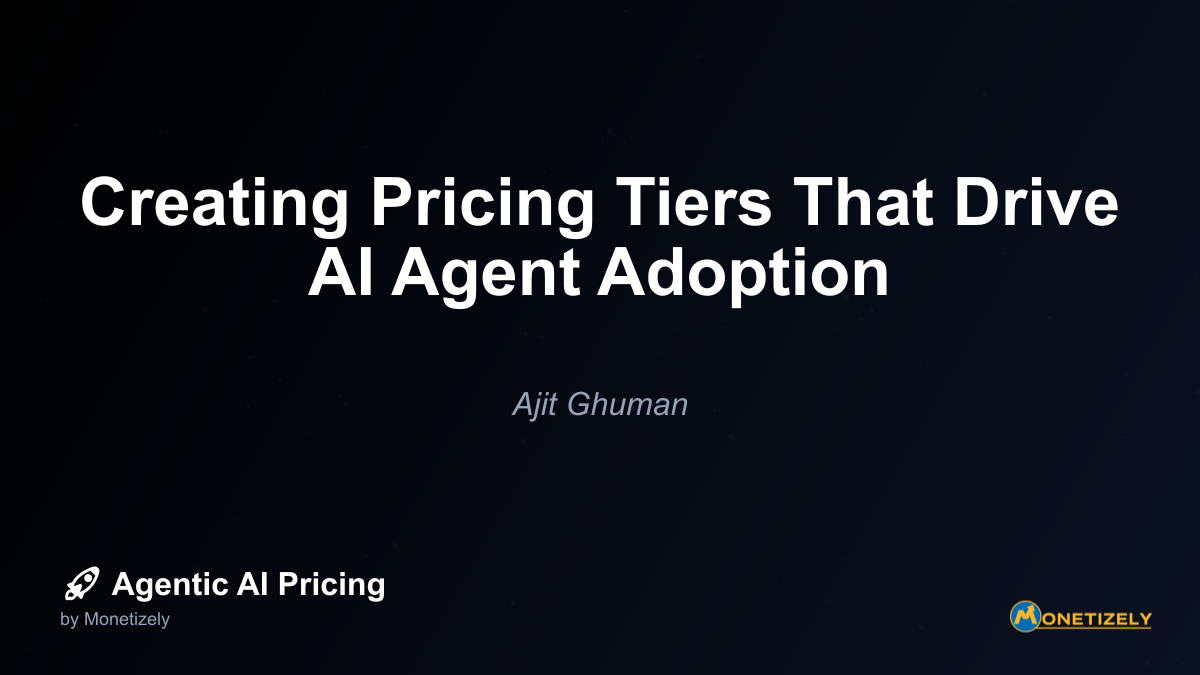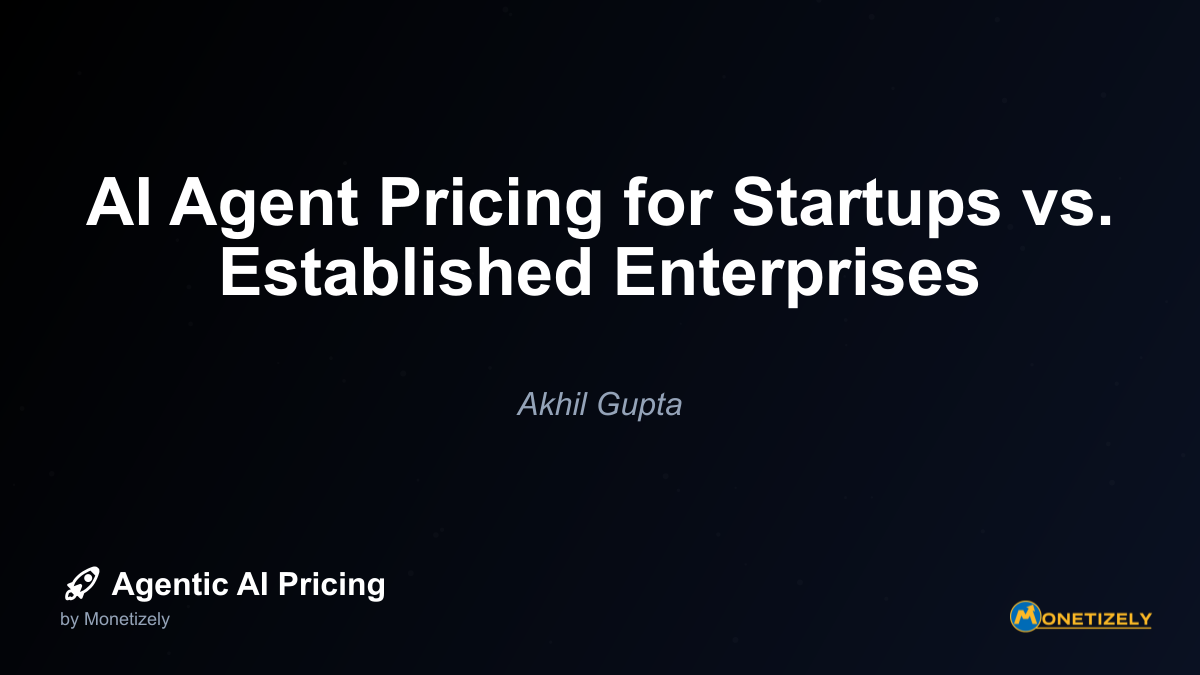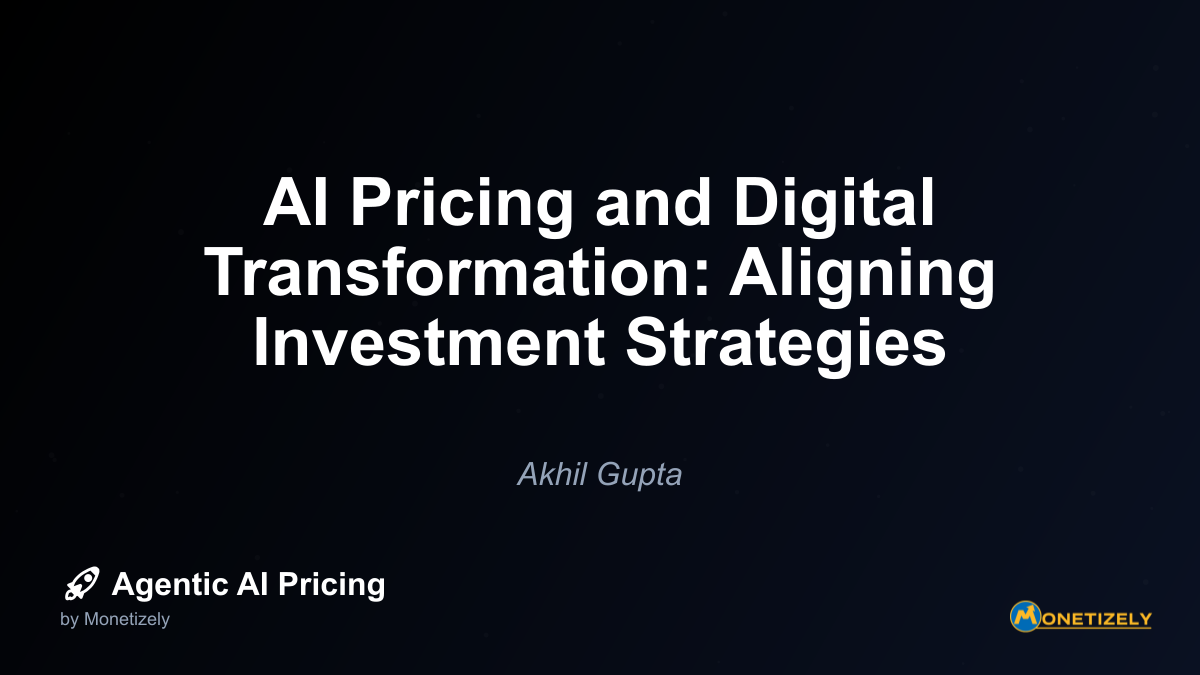· Ajit Ghuman · Strategy · 8 min read
Creating Pricing Tiers That Drive AI Agent Adoption
AI and SaaS Pricing Masterclass
Learn the art of strategic pricing directly from industry experts. Our comprehensive course provides frameworks and methodologies for optimizing your pricing strategy in the evolving AI landscape. Earn a professional certification that can be imported directly to your LinkedIn profile.

For a deeper analysis on freemium approaches specifically for AI agents, you may want to explore our comprehensive guide on weighing the pros and cons of freemium models for AI agents.
Designing Effective Pricing Tiers for AI Agents
Creating pricing tiers that drive adoption requires balancing several factors. Here’s a framework for structuring tiers that encourage both initial adoption and subsequent upgrades:
1. Start with Customer Segments and Use Cases
Effective pricing tiers align with distinct customer segments and use cases. For AI agents, consider segmenting based on:
- Organization size (SMB, mid-market, enterprise)
- Industry vertical (healthcare, finance, retail, etc.)
- Technical sophistication (technical vs. non-technical users)
- Use case complexity (simple automation vs. complex decision-making)
Each tier should provide a complete solution for at least one customer segment or use case, rather than feeling artificially limited.
2. Define Value Metrics That Scale with Usage
The most effective AI agent pricing models use value metrics that naturally scale with customer success. Common value metrics include:
- Number of agent interactions (conversations, tasks completed)
- Frequency of use (daily/monthly active users)
- Volume of data processed (documents analyzed, transactions processed)
- Time saved (automation hours delivered)
- Business outcomes (revenue generated, cost savings)
The ideal value metric directly correlates with the value customers receive, creating a natural upgrade path as usage increases.
3. Structure Tiers Around Capability Levels
For AI agents, capability-based differentiation often works better than purely feature-based approaches. Consider structuring tiers around:
Basic Tier (Free or Low-Cost Entry Point)
- Limited but useful automation capabilities
- Core functionalities with usage caps
- Single-user or limited multi-user access
- Basic integration options
- Standard response times and accuracy levels
Professional Tier (Mid-Market Solution)
- Expanded automation capabilities
- Higher usage limits or removal of caps
- Team collaboration features
- Broader integration options
- Improved response times and accuracy
- Basic customization options
Enterprise Tier (Full-Featured Solution)
- Comprehensive automation capabilities
- Unlimited or very high usage limits
- Organization-wide deployment options
- Advanced integration and API access
- Premium performance and accuracy
- Extensive customization and training options
- Dedicated support and services
4. Create Clear Upgrade Triggers
The most successful pricing strategies include natural triggers that prompt customers to upgrade. These might include:
- Usage-based triggers: When customers approach limits on interactions, users, or data
- Capability triggers: When customers need specific advanced features
- Growth triggers: When customer organizations expand or deploy more broadly
- Success triggers: When value realization reaches a threshold that justifies higher investment
Each tier should include indicators that help customers recognize when they’re ready to move to the next level.
Pricing Communication Strategies That Drive Adoption
How you communicate your pricing structure is as important as the structure itself. Effective pricing communication for AI agents includes:
Transparent Value Articulation
Clearly articulate what customers get at each tier and why it’s worth the investment. For AI agents, focus on:
- Concrete outcomes: What specific problems does the agent solve?
- Quantifiable benefits: How much time or money will customers save?
- Comparative advantages: How does your solution compare to alternatives?
- Success stories: What results have similar customers achieved?
Highlighting the Path to Value
For AI agents specifically, it’s important to communicate how value evolves over time:
- Initial value: What customers can expect immediately
- Growth trajectory: How value increases as the agent learns
- Long-term transformation: The ultimate potential impact
This helps set realistic expectations while building excitement about future possibilities.
Using Social Proof Strategically
Customer testimonials and case studies are particularly important for AI agents, where trust and proof of concept are critical adoption factors. Consider:
- Featuring segment-specific success stories with each tier
- Including ROI calculations and metrics from existing customers
- Highlighting adoption journeys that mirror your target customers’ situations
Common Pitfalls in AI Agent Pricing Tiers
When designing pricing tiers for AI agents, several common mistakes can undermine adoption:
1. Over-Segmenting Features
Dividing features too granularly across tiers can create artificial barriers that frustrate customers. For AI agents, core capabilities should generally remain intact across tiers, with differentiation based on scale, scope, and advanced capabilities.
2. Ignoring the AI Learning Curve
AI agents typically become more valuable over time as they learn from interactions. Pricing tiers that don’t account for this learning curve may undervalue long-term customers or overcharge new ones.
3. Misaligning Value and Price
If pricing doesn’t align with the actual value delivered, adoption will suffer. This is particularly challenging for AI agents, where value can vary significantly across use cases and implementations.
4. Creating Too Much Complexity
Complex pricing structures with numerous tiers, add-ons, and conditions create friction in the buying process. For AI agents, where the technology itself may already seem complex, pricing simplicity becomes even more important.
5. Neglecting Upgrade Paths
Without clear upgrade paths, customers may outgrow their current tier but lack clarity on next steps. This is particularly problematic for AI agents, where usage and value often expand organically over time.
Case Study: Evolution of ChatGPT’s Pricing Tiers
OpenAI’s approach to ChatGPT pricing offers valuable insights into effective tier design for AI agents:
Free Tier:
- Provides basic access to the AI with usage limitations
- Demonstrates core value while creating natural upgrade triggers
- Builds massive user base and awareness
Plus Tier ($20/month):
- Removes usage restrictions
- Provides priority access during peak times
- Offers access to newer models and capabilities
- Creates affordable entry point for committed users
Team Tier ($30/user/month):
- Adds collaboration capabilities
- Includes administrative controls
- Provides workspace for shared resources
- Targets organizational adoption
Enterprise Tier (Custom pricing):
- Offers maximum customization
- Includes advanced security and compliance features
- Provides dedicated support and SLAs
- Targets large-scale organizational deployment
This tiered approach successfully:
- Creates a broad adoption funnel with the free tier
- Provides clear value differentiation between tiers
- Addresses distinct user segments (individuals, teams, enterprises)
- Establishes natural upgrade paths as usage and requirements grow
Pricing Models That Complement Tiered Structures
While tiers provide the foundation of your pricing strategy, they can be enhanced with complementary pricing models:
Usage-Based Components
For AI agents, pure subscription models sometimes fail to align price with value. Consider incorporating usage-based elements:
- Base subscription fee plus usage charges
- Usage credits included in each tier with overage fees
- Volume discounts that automatically adjust pricing as usage scales
Value-Based Pricing Elements
For certain applications, especially in enterprise contexts, value-based pricing can be highly effective:
- Outcome-based pricing tied to specific business results
- Gain-sharing models where you capture a percentage of value created
- ROI-based pricing with guarantees or performance commitments
Add-On and Expansion Options
Rather than cramming every feature into tiers, consider offering specialized add-ons:
- Industry-specific capabilities
- Advanced analytics and reporting
- Premium support and services
- Custom development and training
Testing and Optimizing Pricing Tiers
Pricing is never static, especially for emerging technologies like AI agents. Implement a systematic approach to testing and optimization:
A/B Testing Approaches
Test different tier structures, price points, and feature distributions with:
- Sequential testing (changing pricing over time)
- Segment-based testing (different pricing for different segments)
- Geographic testing (varying pricing by region)
Metrics to Monitor
Track key indicators that signal pricing effectiveness:
- Conversion rates at each tier
- Upgrade/downgrade patterns
- Usage patterns relative to tier limits
- Customer acquisition cost and lifetime value by tier
- Churn rates and reasons by tier
Feedback Mechanisms
Collect qualitative insights to complement quantitative data:
- Customer interviews about pricing perceptions
- Sales team feedback on objections and competitive positioning
- Abandoned cart/signup analysis
- Win/loss analysis for enterprise deals
Building an Upgrade Journey for Customers
The ultimate goal of tier-based pricing is creating a natural progression that aligns with customers’ evolving needs. Here’s how to design this journey:
1. Map the Customer Value Evolution
Document how customer value typically evolves:
- Initial pain points and quick wins
- Secondary use cases that emerge over time
- Advanced capabilities that drive transformation
- Organizational expansion patterns
2. Align Tiers with Value Evolution Stages
Ensure each tier corresponds to a distinct stage in the customer journey:
- Entry tier: Solving initial pain points
- Mid-tier: Expanding use cases and capabilities
- Advanced tier: Enabling transformation and integration
3. Create Educational Pathways
Help customers understand when and why to upgrade:
- Usage dashboards showing approach to limits
- Feature discovery prompts highlighting advanced capabilities
- ROI calculators demonstrating potential value of upgrades
- Success stories featuring customers who have upgraded
4. Implement Proactive Upgrade Prompts
Use data-driven signals to identify upgrade-ready customers:
- Usage patterns approaching tier limits
- Feature requests for capabilities in higher tiers
- Organizational growth indicators
- Success metrics that indicate readiness for expansion
Pricing Communication That Drives Adoption
The presentation of your pricing tiers significantly impacts adoption rates. Consider these strategies:
Emphasize Value Over Features
Rather than listing features, communicate the outcomes each tier enables:
- Basic tier: “Automate routine tasks and save 5+ hours weekly”
- Professional tier: “Transform team productivity with advanced automation”
- Enterprise tier: “Reimagine operations with organization-wide AI”
Use Comparison Tables Effectively
Well-designed comparison tables reduce decision friction:
- Highlight recommended options for different segments
- Use visual cues to draw attention to key differentiators
- Include customer examples or use cases for each tier
Address Objections Proactively
Anticipate and address common concerns:
- ROI calculators that demonstrate value relative to cost
- Satisfaction guarantees or trial periods
- Easy upgrade/downgrade options
- Transparent usage monitoring tools
Conclusion: The Evolution of AI Agent Pricing
As AI agents continue to evolve, pricing strategies must evolve alongside them. The most successful approaches will:
- Start with clear value definition for each customer segment
- Create natural adoption and upgrade paths that align with value realization
- Balance simplicity and flexibility in tier structures
- Communicate value clearly at each stage of the customer journey
- Continuously test and optimize based on market feedback and usage patterns
By designing pricing tiers that reduce initial adoption barriers while capturing appropriate value as usage expands, AI agent providers can build sustainable businesses while accelerating market adoption. The key is viewing pricing not merely as a revenue mechanism but as a strategic tool that shapes how customers experience and derive value from your AI agent technology.
The most successful companies will recognize that pricing strategy is inseparable from product strategy—particularly for AI agents, where the customer journey typically involves expanding use cases and deepening integration over time. By aligning pricing tiers with this natural evolution, you create a win-win scenario where customers receive increasing value while your business captures a fair share of the value created.
As you develop your pricing strategy, remember that the goal isn’t merely to maximize short-term revenue, but to build a sustainable model that encourages widespread adoption, drives customer success, and enables long-term growth. With thoughtfully designed pricing tiers, you can achieve all three objectives while positioning your AI agent solution for market leadership.
Co-Founder & CEO
Ajit is the author of Price To Scale, a top book on SaaS Pricing and is the Founder of Monetizely. Ajit has led and worked in pricing and product marketing at firms like Twilio, Narvar and Medallia. His work has been featured in Forbes and VentureBeat. Ajit regularly consults with software companies from Seed stage to post-IPO on pricing strategy. Ajit is also a highly-rated co-instructor for 'The Art of SaaS Pricing and Monetization' on Maven.
Pricing Strategy Audit
Let our experts analyze your current pricing strategy and identify opportunities for improvement. Our data-driven assessment will help you unlock untapped revenue potential and optimize your AI pricing approach.




